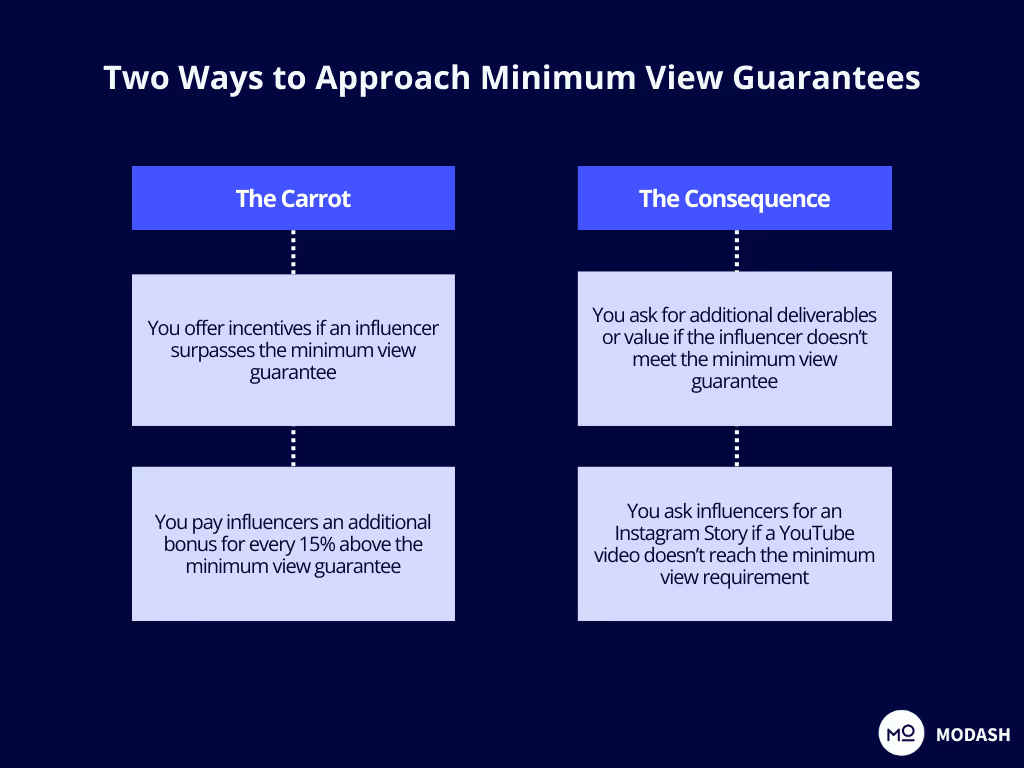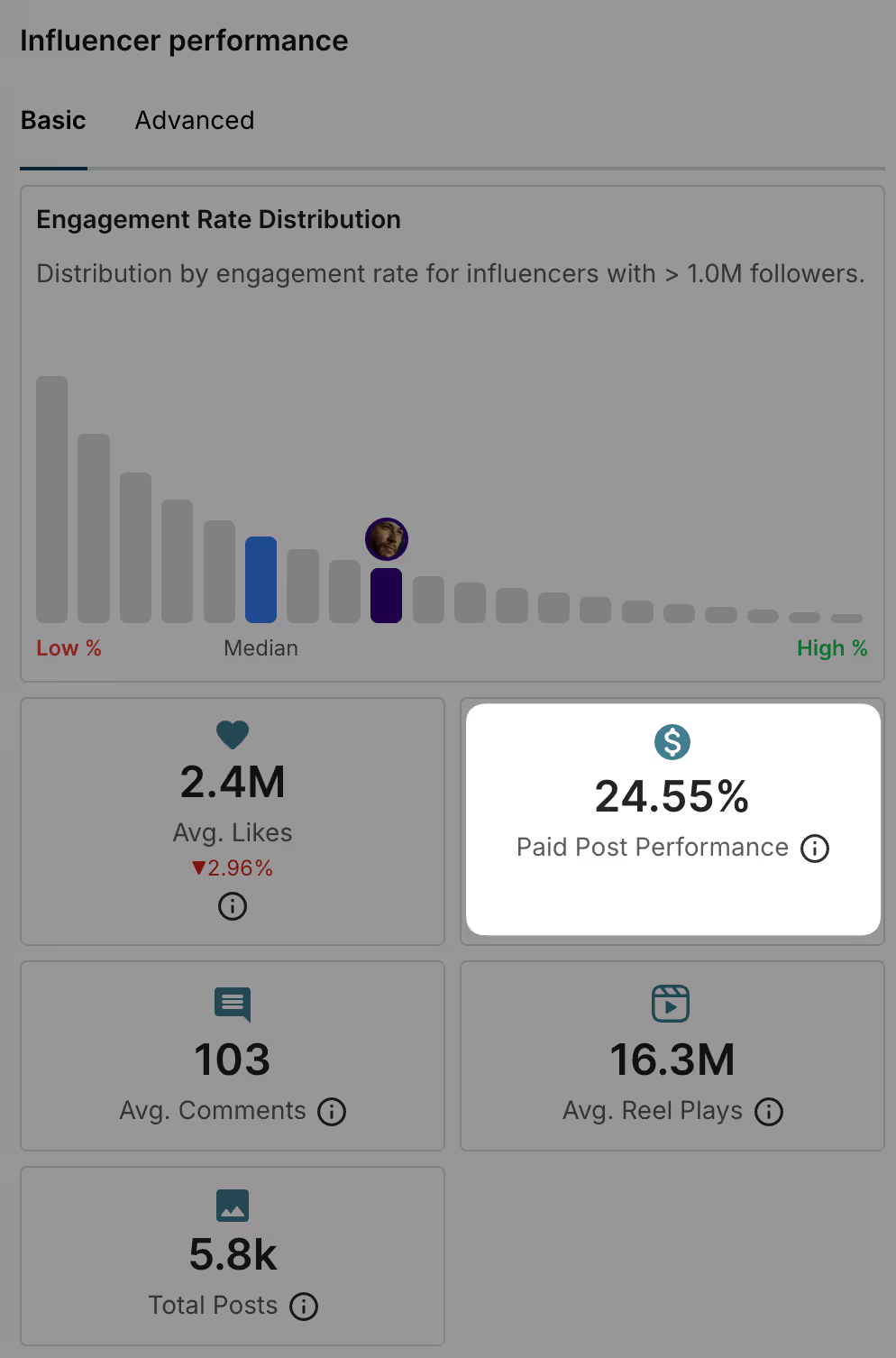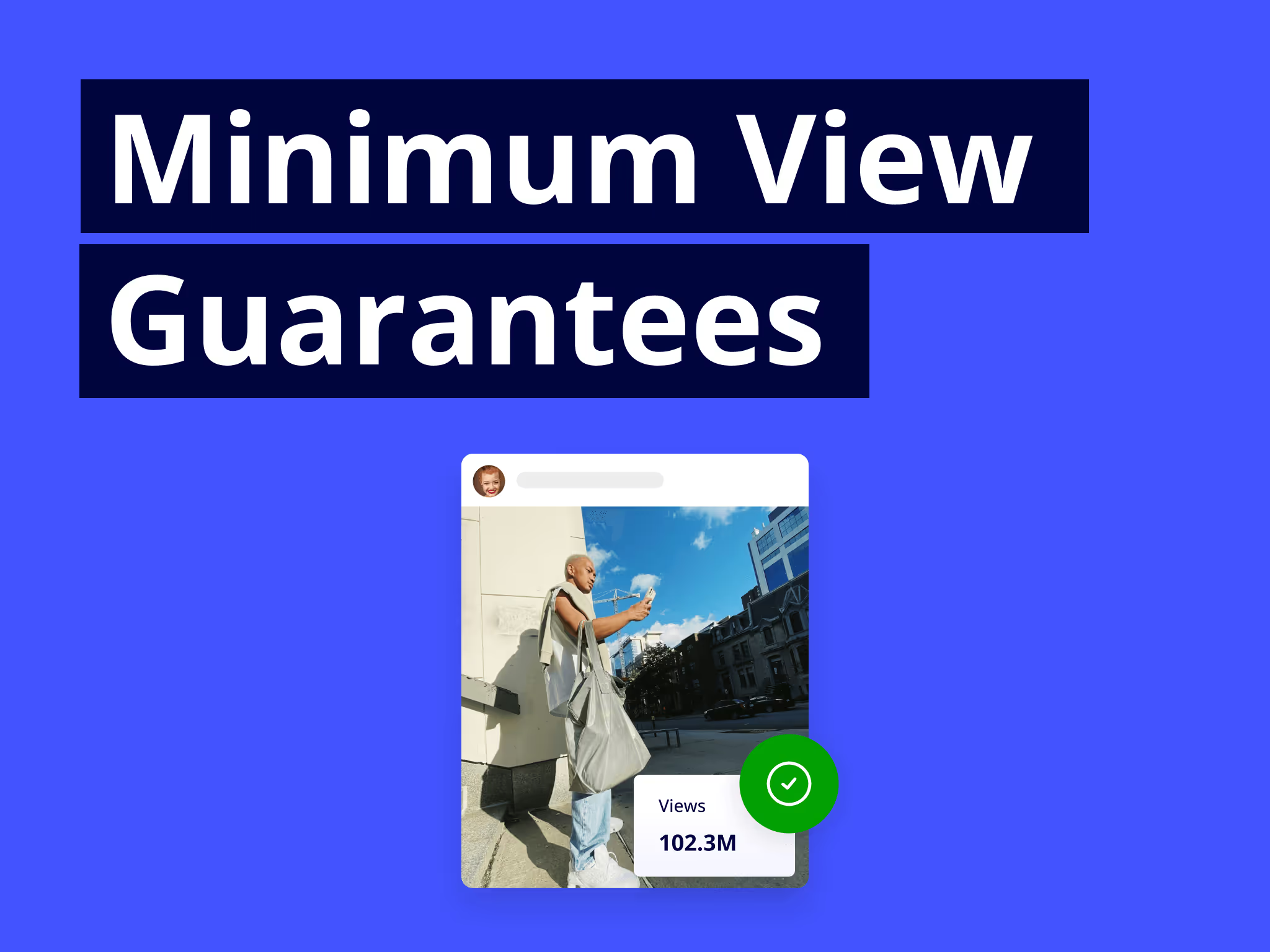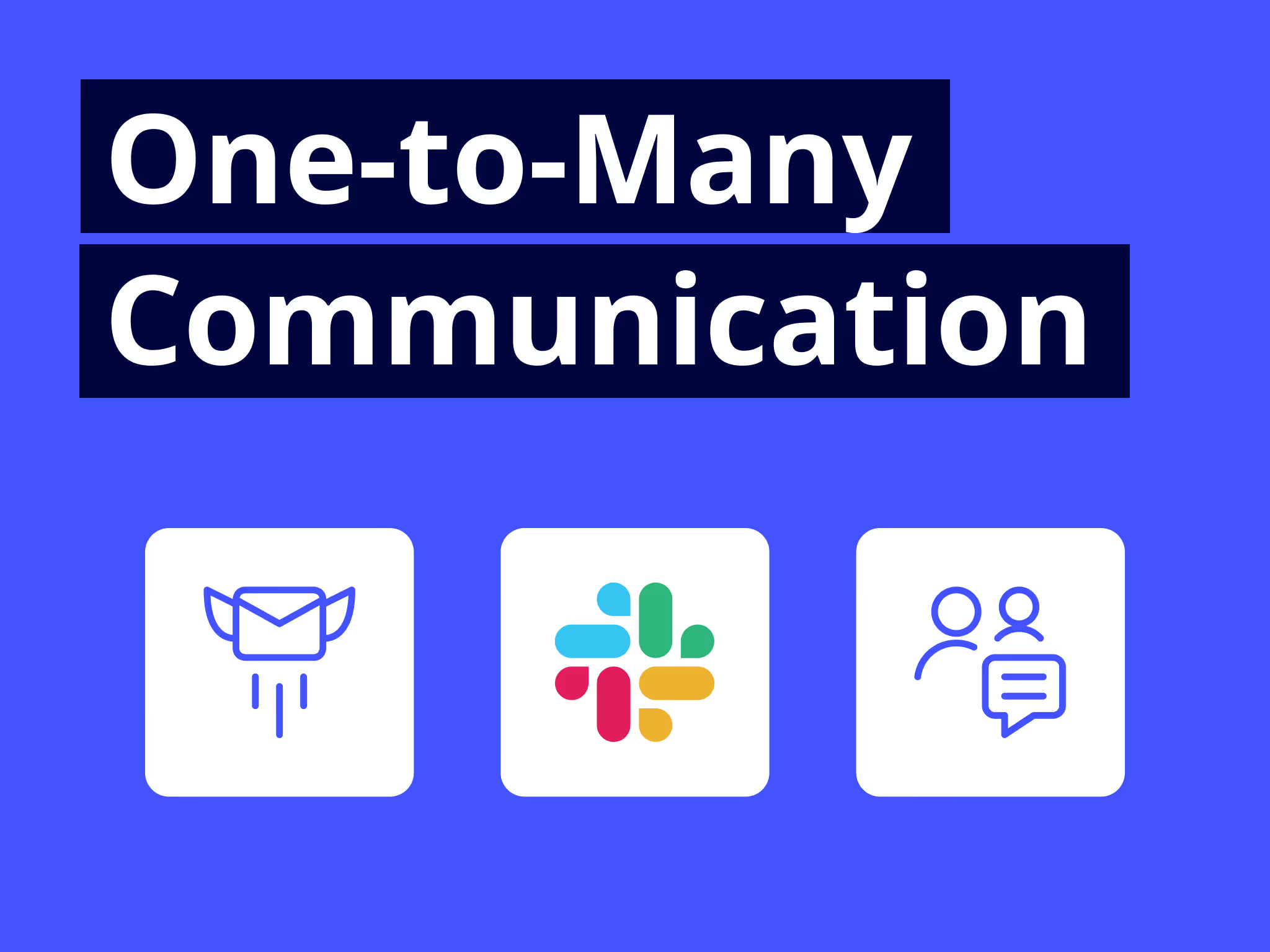A minimum view guarantee (MVG) is precisely what it sounds like: you ask the influencer (or their agency) to deliver a certain number of views on the content they create for you. For instance, you want a minimum of 30k views on the sponsored Instagram Reel.
Here’s the thing: minimum view guarantees are generally a bad idea. Creators can’t control the algorithm and asking for MVG often strains your creator relationships, too. No wonder why 58.3% of respondents in our survey said they never use them.
That said, if you absolutely must use minimum view guarantees, this article will show you how to implement them properly without damaging your influencer relationships or brand reputation.
Minimum view guarantees as carrots vs. consequences
MVGs are primarily used in two ways in influencer marketing:
- As a carrot: this is when you propose the minimum view guarantee as an incentive. If the influencer reaches it, great – they get an additional flat fee. Or the more they surpass the MVG, the more rewards they get. It’s kind of like affiliate marketing where you pay influencers based on how many conversions they bring in.
- As a consequence: this is when you propose that an influencer has to provide extra value if they don’t hit the minimum view guarantee. For instance, if a YouTube video doesn’t perform as expected, the influencer will add an Instagram Story deliverable at no cost. Or you can also negotiate adding/extending usage rights if you plan to repurpose the influencer content.

Keep the above approaches in mind as you read ahead.
In general, it’s better to frame minimum view guarantees as a carrot because the conversation can be reframed to be more positive and uplifting instead of threatening. That said, there are also sensitive approaches to using minimum view guarantees as a consequence – more on that in the next sections.
Can you use both? Of course. It all depends on how you approach it. You can say, “Hey, we’d love it if the content gets minimum XY views. If it doesn’t, would you be open to making up for it by [consequence]? If you cross this threshold, though, we’d love to thank you by [carrot]!”
But remember using both approaches simultaneously might bloat your influencer contract with too many conditions beyond a creator’s control.
The case against minimum view guarantees
Here are five reasons why you might want to steer clear off implementing minimum view guarantees:
1: A creator can’t control the algorithm
We don’t need to tell you social media algorithms have a reputation for being wildly unpredictable. Creators, despite their best efforts, might not see the results you were expecting because they’re at the mercy of algorithms. Influencer marketing expert, Katie Stoller, explains how environmental factors – beyond anyone’s control – can affect a post’s performance:
Since creators aren't fully in control of the ups and downs in their views, it’s unfair to ask them to guarantee anything.
2: MVGs put unnecessary pressure on the influencers
No one can control the algorithm and how a post performs in the wild under organic social media. Asking for minimum view guarantees can pressure the influencers to achieve a baseline – especially under the ‘consequence’ approach. A creator might worry, “I’ll have to create more content if this one flops.”
Zia Ur Rehman Awais, Influencer Marketing Manager at Vitauthority, also mentioned how minimum view guarantees can restrict a creator’s authenticity:
Instead of thinking about creating the best content for your ICP, influencers might begin to work from the lens of maximizing views – which can also lead them to purchase impressions. It becomes a lose-lose situation.
3: MVGs strain your influencer relationships
Asking for a minimum view guarantee can make the influencer feel that you don’t trust them or value their content creation capabilities. Simoné Partner explains what her thought process would be if a brand asked her for MVG:
When you collaborate with influencers, you aren’t just paying for views. You’re paying for their content creation abilities, borrowing the trust of their community, and for the time they spent testing out your product and filming it.
Influencer relationships are your most valuable asset. Requesting minimum view guarantees can often weaken them because they create an air of distrust and disrespect.
4: Asking for MVGs can hurt your brand reputation
Creators often view brands demanding minimum view guarantees as a red flag. When you ask creators to guarantee a certain number of views in the world of unstable algorithms, you can come across as unreasonably demanding and difficult to work with. Simoné agrees:
It goes without saying that this is situation-dependent. There are plenty of ways to approach the minimum view guarantee conversation smoothly and not risk your brand reputation. But it’s a sensitive topic – one misunderstanding or unreasonable demand (no matter how well-intentioned) can put you in a creator’s black book.
5: It’s not all about the views
The core of minimum view guarantee is the ‘views’ an influencer gets on their content. But views don’t always translate to meaningful brand awareness or sales. Simoné recalls a time when a brand collaboration didn’t get as many views, but outperformed in terms of conversions:
Anna also agreed that sometimes (especially in low-lift content types like Instagram Stories), asking and tracking minimum view guarantees is also adding an (albeit unnecessary) task on your to-do list:
As we also discussed before, when you pay a creator, you’re not just paying them for views. You’re also paying them to build trust for your brand in their community, create content you can repurpose, and provide helpful reviews. Tying a creator’s payment to just a view guarantee (that’s also not 100% in their control) can feel unfair and oversimplified.
Why marketers might think about using minimum view guarantees
You might be wondering if minimum view guarantees can cause reputation damage, why do marketers consider using them? Here are two core reasons:
1: MVGs de-risk your investment (especially when you want to experiment)
The biggest benefit of minimum view guarantees is they introduce predictability into an unpredictable channel. With the safety net of a minimum view guarantee, you make your investment in influencer marketing slightly more reliable. You can distribute your budget more confidently when you know the minimum of what you’ll (hopefully) get back and how you’ll make up for it if you don’t.
This is especially true when you want to experiment: let’s say you want to partner with a macro-influencer but their rates are out of your budget. Or you want to test influencers outside your niche. Perhaps a potential creator partner has large fluctuations in their impressions.
In all the above scenarios, minimum view guarantees can protect your brand against unpredictable results. Namrata Thakker, Head of Communications, PR, and Influencer Marketing at Bestseller India, uses minimum view guarantees as a protection shield when partnering with macro-influencers:
Minimum view guarantees make for a good negotiation tactic in risky or expensive collaborations. For instance, Anna-Maria Klappenblach recalled a time when she really wanted to work with an influencer but:
- Their rates were out of the budget
- Their views were fluctuating too much – so it could go too well or too poorly
When Anna transparently shared how her budget was decided based on views and theirs was not only stretching the wallet but also slightly unreliable, the influencer negotiated using a minimum view guarantee. Talk about an uno-reverse:
If you want to work with an influencer who’s a risky bet or out of budget, you can use minimum view guarantees to negotiate and make your investment slightly more predictable and less risky.
2: MVGs set performance expectations
Minimum view guarantees help set the right expectations from creators upfront – which can help clarify campaign goals. With minimum view guarantees, creators know the baseline of what’s expected from their content and why.
How to approach minimum view guarantees: 5 best practices
If you want to use minimum view guarantees in your influencer collaborations, remember these five best practices so you don’t hurt your brand credibility:
1: Be open, honest, and upfront about your expectations
Pairing sneakiness with minimum view guarantees is the worst combination. You come across as shady if you try to slip it in directly into the contract or bring it up much later in the content creation process. It can also lead a creator to trust you less (‘What else is this brand trying to get away with?’) and cause a bad feeling about the relationship.
Luke Raben, Growth Manager at LABFRESH, agrees:
Bring up your expectations with minimum view guarantees early in the collaboration process. And be open to answering questions a creator might have and soothe their worries:
- Why do you need a minimum view guarantee?
- What is the minimum view guarantee for this campaign?
- How are you calculating the ‘minimum’ number an influencer should reach?
- What happens if an influencer isn’t able to meet the minimum view guarantee?
- What if undeniable outside factors (like shocking news) affect their engagement?
The more open, honest, and upfront you are, the more influencers will feel confident partnering with you – despite the MVG ask.
2: Make your ask a relatively small one
Note: This best practice only applies if you take the consequences approach.
The biggest mistake marketers make with minimum view guarantees is having unreasonable demands. Don’t demand a creator to shoot another YouTube video (or even a Reel) if their first one didn’t reach the baseline number of views. That’s a big ask. It can make the creator feel like you’re trying to get away with scope creep.
Instead, keep your ask relatively small and reasonable – such as an Instagram Story or adding/extending the usage rights by a month or so. And discuss it in advance. Simoné explained with an example:
⚠️ Note: Simone shared the above example in the context that there’s no ‘official’ agreement for a minimum view guarantee in the influencer’s contract. The purpose is to highlight that creators aren’t unreasonable and would understand your requirements – even if you don’t explicitly include an MVG in your agreement.
It’s simple: the goal with minimum view guarantees should be to de-risk your investment, not overextending your demands on creators.
3: Keep the minimum number lower than the median/average performance of a creator’s sponsored posts
How do you decide the ‘minimum’ of the minimum view guarantee? Don’t pull a number out of thin air or one that ‘sounds’ good to hear. Instead, root it in past performance data – it’s the far more reliable and realistic alternative. Anna suggests using the median of their sponsored content’s performance and slashing off 20% of that number for good measure.
This has two benefits:
- You don’t put too much pressure on the influencer since the MVG is achievable
- You set realistic expectations for your stakeholders and team members
What’s important to remember here is to decide your minimum view guarantee based on the average or median of an influencer’s sponsored content. Sponsored content rarely performs as well as organic content – so you can’t base your MVG on the overall content performance. Katie agrees:
And don’t worry: you don’t have to manually filter sponsored content from an influencer’s page and calculate the median/average views. You can avoid that headache easily with Modash. It compares the likes of paid posts to the likes of sponsored posts.

The higher the percentage, the less the gap between organic and sponsored posts’ performance. Use this percentage number to guide your MVG. You can also see an influencer's sponsored content separately in Modash's creator profile analysis.

4: Frame minimum view guarantee as an incentive
Note: This best practice only applies if you take the carrots approach.
Offering incentives always appears to be the kinder and more polite choice than serving a punishment. An anonymous participant in our survey explained why the carrot approach is often better than the consequences approach (at least in framing it on paper):
“Using a bonus with a minimum view guarantee often works better than a consequence, particularly in motivating influencers to exceed expectations. When influencers are rewarded for surpassing the view target, they’re often more invested in engaging with their audience and promoting the content more effectively, leading to better results.”
In the consequences approach, you’re likely adding another task on the influencer’s plate if they don’t meet your requirements – which is fair, but it feels like a punishment. On the other hand, the carrot approach feels like a bonus for outperforming expectations. There’s less pressure and more excitement.
If you choose to go via the carrot route, frame it as a win-win for the creator: show them how you’ll reward them if they exceed your minimum view guarantee expectations. Here are three incentive ideas:
- Flat fee: pay an additional flat fee every time the view crosses a threshold. For instance, $200 extra for every 15% above the minimum.
- Tiered bonus structure: you can offer a tiered bonus structure where the influencer earns more depending on how far they stretch the margin. For example, they might get a small extra fee for exceeding 10-15% of your MVG, but exceeding it by 40-50% triggers a much larger payout.
- Goodies: if you’re influencer marketing for an expensive product, you can also reward creators with free products for them, their friends, and their families. Or maybe an invite to a company event where they can make useful connections.
Think about what would make the minimum view guarantee worth a creator’s effort and fit it into your proposal as an incentive.
5: Offer flexibility
If an influencer resists minimum view guarantees, try to understand why. They might have a good reason! If you can satisfactorily answer their concerns, it will only strengthen your relationship (and ease the pressure).
When applicable, don’t hesitate to be flexible. It’s a negotiation, after all, and you’ve got to meet halfway. An anonymous participant in our survey also agreed:
“Be open to adjusting the guarantee if the influencer presents strong reasoning (e.g., if they expect lower engagement due to seasonality or a shift in platform algorithms). Flexibility helps build a stronger working relationship.”
For instance, if the creator negotiates increasing their flat fee slightly or reducing the ‘make-up’ deliverables, be open to hearing them out and arrive at a common ground.
Having access to in-depth influencer data can eliminate the need for MVGs
You might gravitate toward MVGs because it makes you more confident in your campaign and a creator’s performance. But it signals that you don’t trust an influencer’s ability, damaging your creator relationships.
A better way to be confident about a creator’s performance is to arm yourself with data: if you can check an influencer’s past performance, audience demographics, average reach, and followers’ interests, you’ll have a pretty good ballpark of what to expect without asking an influencer to guarantee anything.
Want to analyze an influencer’s profile in-depth? Start by signing up to Modash (for free!) – it has every detail about an influencer you might possibly need, including sponsored posts and their performance against organic posts.












